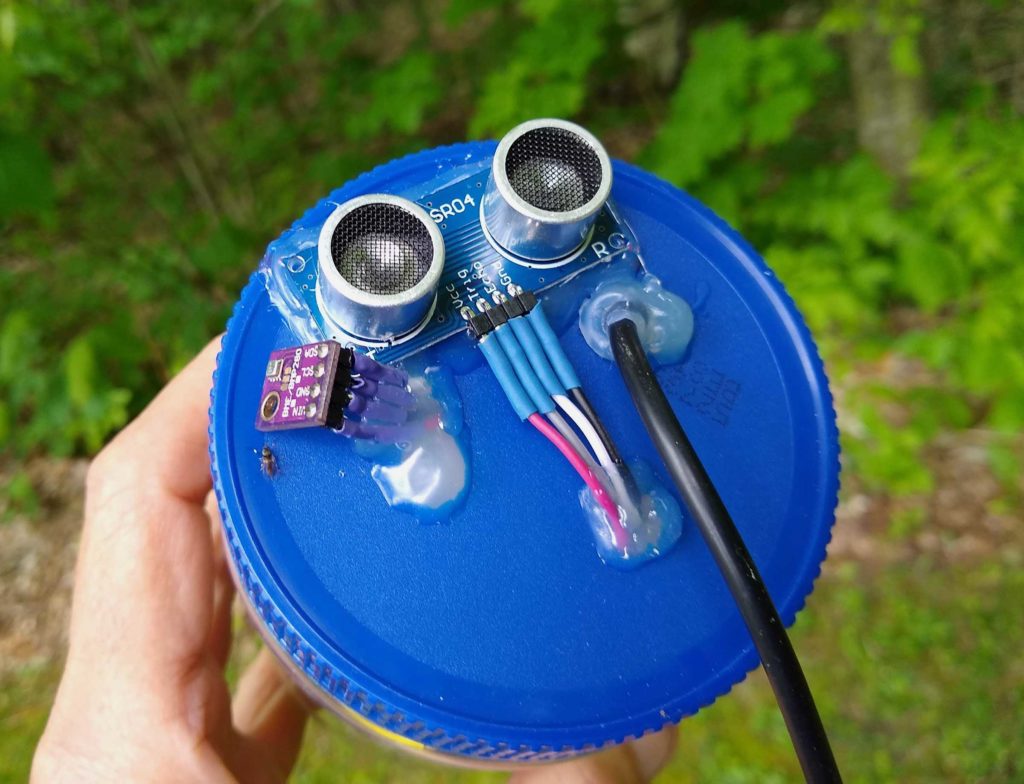Six weeks ago I installed version 3 of a water depth data logger in the vernal pool we are monitoring. I liked that logger more than the earlier versions because the parts cost $35 instead of $50. After posting about it I noticed that many Arduino hobbyists measure distance with an ultrasonic rangefinder instead of the laser rangefinder I had used, so I ordered a few HC-SR04p rangefinders.

There were three important unknowns about this ultrasonic sensor, but after some testing I learned that 1) it is very good at measuring the distance down to a surface of water, and 2) it can be run on 3.3 volts, and 3) it does not require an Arduino with a lot of memory. These three features allowed me to make a new version of the vernal pool water-depth data-logger with a remarkable characteristic — the parts cost only $17.00, half the cost of the last version (see BOM below).

Four serendipitous things allow this. First, ultrasonic rangefinders cost $1.00 instead of $7.00 for the laser rangefinder. Second, the laser rangefinder used in the previous versions is hard to run without a beefy Arduino microcontroller with enough memory for its big library. The ultrasonic rangefinder does not even need a library and runs great on a basic 328p Arduino like a Pro Mini. That saves $8.00. Third, the laser rangefinder does not work in bright light so I used a light sensor to keep track of when the laser readings were unreliable. The ultrasonic sensor works regardless of light level, so we can save $6.00 by eliminating the light sensor and also get continuous water level data. Fourth, although the basic ultrasonic rangefinders run on 5 volts, some models seem to do fine on just 3.3 volts. That allows them to run on the Arduino Pro Mini with other common and inexpensive data-logging components that can run for months on batteries. The rangefinders I bought are labelled “HC-SR04p,” and that “p” might be an important designation that it can run on 3.3v.

Another advantage of the ultrasonic rangefinder compared to the laser rangefinders is that bouncing the sound signal off a water surface works very well. I had to float a target under the laser rangefinder versions, but that is not needed with the new version. That may not save any money, but it makes installing the logger easier and eliminates a fragile moving part.

Yet another minor advantage of the Version 4 logger is that the low-power timer works well with the Arduino Pro Mini and does not need to be kludged with the capacitor I added to make it work with the Adafruit Feather or ItsyBitsy.





Bill of materials. These are prices on eBay or Amazon including shipping, but sometimes you have to order more than one to get these prices.
- Arduino Pro Mini (3.3v) …………………………………$3.00
- Adafruit low power timer (TPL5110) …………………..$5.00
- Real-time clock (DS3231) ………………………………$1.00
- MicroSD module (3.3v) ………………………………….$1.00
- MicroSD card (1 or 2 GB) ……………………………….$3.00
- Ultrasonic rangefinder (HC-SR04p) ……………………$1.00
- Temp, pressure, humidity sensor (BME280, 3.3v) ……$1.00
- Water temperature sensor (DS18B20) …………………$1.00
- Battery case (4 AA) ……………………………………….$1.00
- Total ………………………………………………………$17.00
I hope to install the new logger in our vernal pool soon and also retrieve the data from the two loggers already there [I did just that].
The sketch running on the Arduino Pro Mini is here.
